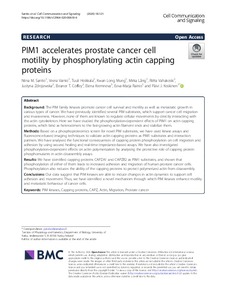| dc.contributor.author | Elena Kremneva | |
| dc.contributor.author | Veera Vainio | |
| dc.contributor.author | Mirka Lång | |
| dc.contributor.author | Riitta Vahakoski | |
| dc.contributor.author | Niina M. Santio | |
| dc.contributor.author | Kwan Long Mung | |
| dc.contributor.author | Tuuli Hoikkala | |
| dc.contributor.author | Eeva-Marja Rainio | |
| dc.contributor.author | Eleanor T. Coffey | |
| dc.contributor.author | Päivi J. Koskinen | |
| dc.contributor.author | Justyna Zdrojewska | |
| dc.date.accessioned | 2022-10-28T12:28:17Z | |
| dc.date.available | 2022-10-28T12:28:17Z | |
| dc.identifier.uri | https://www.utupub.fi/handle/10024/159731 | |
| dc.description.abstract | <p>
<strong>
Background:
</strong>
The PIM family kinases promote cancer cell survival and motility
as well as metastatic growth in various types of cancer. We have
previously identified several PIM substrates, which support cancer cell
migration and invasiveness. However, none of them are known to regulate
cellular movements by directly interacting with the actin cytoskeleton.
Here we have studied the phosphorylation-dependent effects of PIM1 on
actin capping proteins, which bind as heterodimers to the fast-growing
actin filament ends and stabilize them.
</p>
<p>
<strong>
Methods:
</strong>
Based on a phosphoproteomics screen for novel PIM substrates, we
have used kinase assays and fluorescence-based imaging techniques to
validate actin capping proteins as PIM1 substrates and interaction
partners. We have analysed the functional consequences of capping
protein phosphorylation on cell migration and adhesion by using wound
healing and real-time impedance-based assays. We have also investigated
phosphorylation-dependent effects on actin polymerization by analysing
the protective role of capping protein phosphomutants in actin
disassembly assays.
</p>
<p>
<strong>
Results:
</strong>
We have identified capping proteins CAPZA1 and CAPZB2 as PIM1
substrates, and shown that phosphorylation of either of them leads to
increased adhesion and migration of human prostate cancer cells.
Phosphorylation also reduces the ability of the capping proteins to
protect polymerized actin from disassembly.
</p> | |
| dc.language.iso | en | |
| dc.publisher | BioMed Central Ltd. | |
| dc.title | PIM1 accelerates prostate cancer cell motility by phosphorylating actin capping proteins | |
| dc.identifier.urn | URN:NBN:fi-fe2021042824740 | |
| dc.relation.volume | 18 | |
| dc.contributor.organization | fi=psykiatria|en=Psychiatry| | |
| dc.contributor.organization | fi=fysiologia ja genetiikka|en=Physiology and Genetics| | |
| dc.contributor.organization | fi=biologian laitoksen yhteiset|en=Department of Biology| | |
| dc.contributor.organization | fi=biotiedekeskuksen yhteiset|en=Biotiedekeskuksen yhteiset| | |
| dc.contributor.organization | fi=biolääketieteen laitos, yhteiset|en=Institute of Biomedicine| | |
| dc.contributor.organization-code | 2607316 | |
| dc.contributor.organization-code | 2609200 | |
| dc.contributor.organization-code | 2606404 | |
| dc.contributor.organization-code | 2607100 | |
| dc.contributor.organization-code | 2606400 | |
| dc.converis.publication-id | 48702179 | |
| dc.converis.url | https://research.utu.fi/converis/portal/Publication/48702179 | |
| dc.identifier.eissn | 1478-811X | |
| dc.identifier.jour-issn | 1478-811X | |
| dc.okm.affiliatedauthor | Rainio, Eeva | |
| dc.okm.affiliatedauthor | Zdrojewska, Justyna | |
| dc.okm.affiliatedauthor | Vainio, Veera | |
| dc.okm.affiliatedauthor | Coffey, Eleanor | |
| dc.okm.affiliatedauthor | Kwan Long, Mung | |
| dc.okm.affiliatedauthor | Santio, Niina | |
| dc.okm.affiliatedauthor | Vahakoski, Riitta | |
| dc.okm.affiliatedauthor | Lång, Mirka | |
| dc.okm.affiliatedauthor | Koskinen, Päivi | |
| dc.okm.discipline | 3111 Biomedicine | en_GB |
| dc.okm.discipline | 3111 Biolääketieteet | fi_FI |
| dc.okm.discipline | 3122 Cancers | en_GB |
| dc.okm.discipline | 3122 Syöpätaudit | fi_FI |
| dc.okm.discipline | 1182 Biochemistry, cell and molecular biology | en_GB |
| dc.okm.discipline | 1182 Biokemia, solu- ja molekyylibiologia | fi_FI |
| dc.okm.internationalcopublication | not an international co-publication | |
| dc.okm.internationality | International publication | |
| dc.okm.type | Journal article | |
| dc.publisher.country | Britannia | fi_FI |
| dc.publisher.country | United Kingdom | en_GB |
| dc.publisher.country-code | GB | |
| dc.relation.articlenumber | 121 | |
| dc.relation.doi | 10.1186/s12964-020-00618-6 | |
| dc.relation.ispartofjournal | Cell Communication and Signaling | |
| dc.relation.issue | 1 | |
| dc.year.issued | 2020 | |
